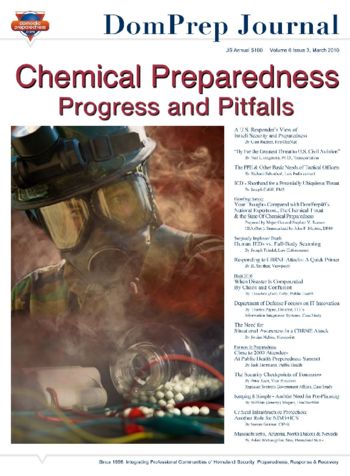

The PPE & Other Basic Needs of Tactical Officers
Richard Schoeberl
March 10, 2010
An alarming report issued by the WMD Commission – combined with the growing need to “protect the protectors” and an increase in other responsibilities – suggests that law-enforcement agencies, specifically including SWAT teams, may soon have to become hazmat experts as well.

Keeping It Simple – And the Need for Pre-Planning
William (Jeremy) Magers
March 10, 2010
Question: How does an all-electric racing car work? Answer: By pushing the “start” button. One of the biggest problems in the field of domestic preparedness, it says here, is the misguided instructional emphasis on theory and complex technology rather than maintaining a laser-beamed focus on practical training, the explanation of fundamentals, and drills, exercises, and more training. Then practice, practice, and more practice.

Training Tests State Agency’s Response to Natural & Man-Made Disasters
Domestic Preparedness
March 10, 2010
The Wisconsin Emergency Management (WEM) & the Federal Emergency Management Agency (FEMA) conducted training designed to better prepare Wisconsin’s many state agencies to effectively manage a major disaster. During a four-day training exercise, more than 75 local, state, volunteer, and federal emergency responders tested emergency response and recovery plans to respond to a multiple-event “emergency.”

Compare Your Thoughts with Those from National Experts on … The Chemical Threat and the State of Chemical Preparedness
Stephen Reeves and John F. Morton
March 10, 2010
How serious is the chemical threat now facing the United States and its allies throughout the
world? Also, are U.S. responder agencies properly prepared to cope with that threat? If not, why not?
What additional policies and actions are needed? Those are just a few of numerous questions posed in
this DomPrep40 survey. Readers are hereby requested, and challenged, to compare their opinions with
those of the DP40 panel of experts.

Missouri C-130s, Crews Divert to Chile
Jim Greenhill
March 9, 2010
Two Missouri Air National Guard C-130 Hercules transport aircraft, with 47 crew members, were diverted to Chile to aid that earthquake-ravaged nation. The C-130 aircraft can fly passengers, and airlift cargo, long distances – in all weather conditions, both day and night, from low to high altitudes – and land in many areas inaccessible to other aircraft.

Haiti 2010: When Disaster Is Compounded by Chaos & Confusion
Theodore Tully
March 3, 2010
Within minutes after news of the 12 January earthquake that devastated Haiti was reported to the outside world, U.S. government agencies, and numerous NGOs, swung into action. Here is a lessons-learned report on how New York City’s Mount Sinai Hospital accelerated its pre-planning process, the preparation of healthcare volunteers, the procurement of medical supplies and equipment, and the dispatch to Port au Prince of an all-volunteer medical relief team.

ICD – Shorthand for a Potentially Ubiquitous Threat
Joseph Cahill
March 3, 2010
Chemicals are a part of the everyday American’s diet. They are used – in carefully measured doses, it is hoped – in manufacturing; in the processing of food, beverages, medicines, and numerous other consumables; and in many other ways in almost every country in the world. Because of their relatively low cost and easy availability, moreover, they are particularly well suited for use by terrorists as homemade bombs and roadside ICDs.

FINAL REPORT: The Security of National Infrastructure
Dennis R. Schrader
February 28, 2010
The DP40 and DomPrep readers where asked how they view the apparent transition from thinking in
terms of critical infrastructure protection to thinking in terms of critical infrastructure resilience.

